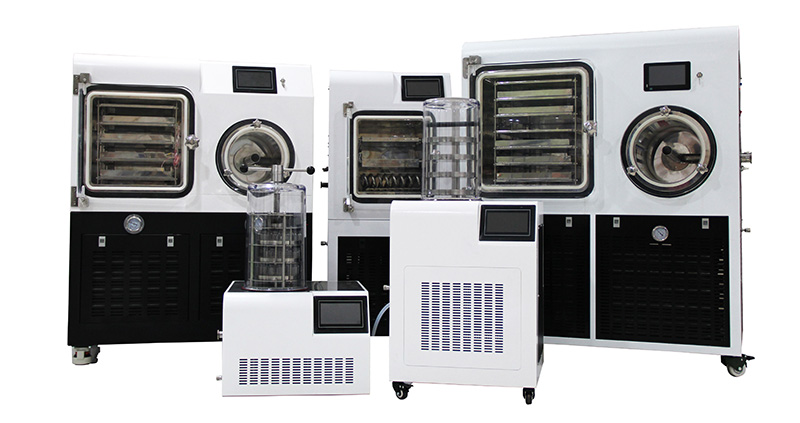There are some important differences between Shanghai Yetuo vacuum freeze dryer (also known as freeze dryer) and ordinary drying methods.
1. Working principle: The vacuum freeze dryer dries samples by combining low temperature and vacuum conditions. Firstly, the sample is frozen to form ice crystals, and then vacuum is applied at low temperature to directly transform the ice crystals from solid to gas, bypassing the liquid phase (i.e. sublimation of ice). On the contrary, the common drying method usually involves placing the sample at room temperature and evaporating the moisture by providing heat.
2. Drying speed: The vacuum freeze dryer has a fast drying speed. Due to the effects of low temperature and vacuum conditions, moisture is removed through sublimation, thereby increasing the drying speed. In contrast, ordinary drying methods require longer time to evaporate moisture.
3. Preserve sample characteristics: Vacuum freeze dryer can better preserve the characteristics of the sample. Due to the drying of the sample in a frozen state, the structure and properties of the sample are preserved during the sublimation of ice crystals, reducing the impact of the drying process on the sample. However, ordinary drying methods may cause damage or changes to the sample structure.
4. Applicability: The vacuum freeze dryer is suitable for various types of samples, including biological samples, food, drugs, chemicals, etc. It can effectively dry samples with high moisture content or temperature sensitive samples. The applicability of ordinary drying methods is relatively narrow, especially for situations where sample characteristics need to be preserved.
5. Retain active ingredients: Vacuum freeze dryer can better preserve the active ingredients in the sample. Due to the direct transformation of water from solid to gas during the freeze-drying process, without the need for liquid, it helps to maintain the stability and activity of the active substances in the sample. For samples that require the retention of active ingredients, such as biologics, drugs, etc., vacuum freeze-drying is an ideal choice.
6. Avoid pollution and oxidation: Vacuum freeze dryers can dry in low temperature and low oxygen environments, thereby avoiding oxidation and pollution problems. During the ordinary drying process, some sensitive components in the sample may undergo oxidation reactions or be contaminated by microorganisms in the air due to exposure to air. Vacuum freeze-drying reduces the occurrence of these problems by reducing the presence of oxygen and moisture.
7. Operation control: Vacuum freeze dryers are usually equipped with advanced control systems that can achieve precise control of parameters such as temperature, vacuum degree, and drying time. This makes the operation more convenient and controllable, and can be adjusted according to the needs of different samples. Ordinary drying methods are usually relatively simple and easy to operate, but they cannot provide similar precise control.


 Alibaba Store
Alibaba Store Tmall Store
Tmall Store Jingdong Sstore
Jingdong Sstore







